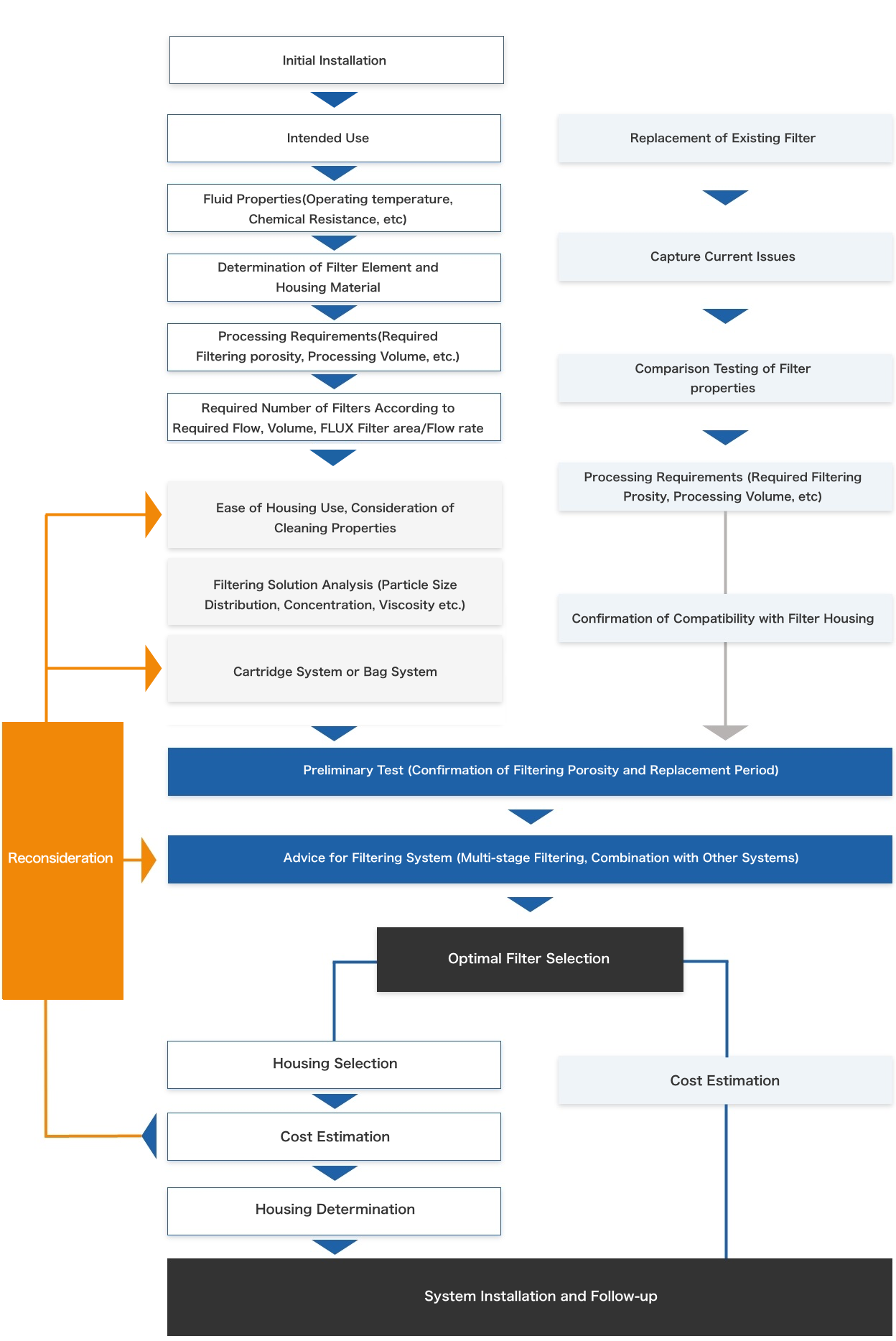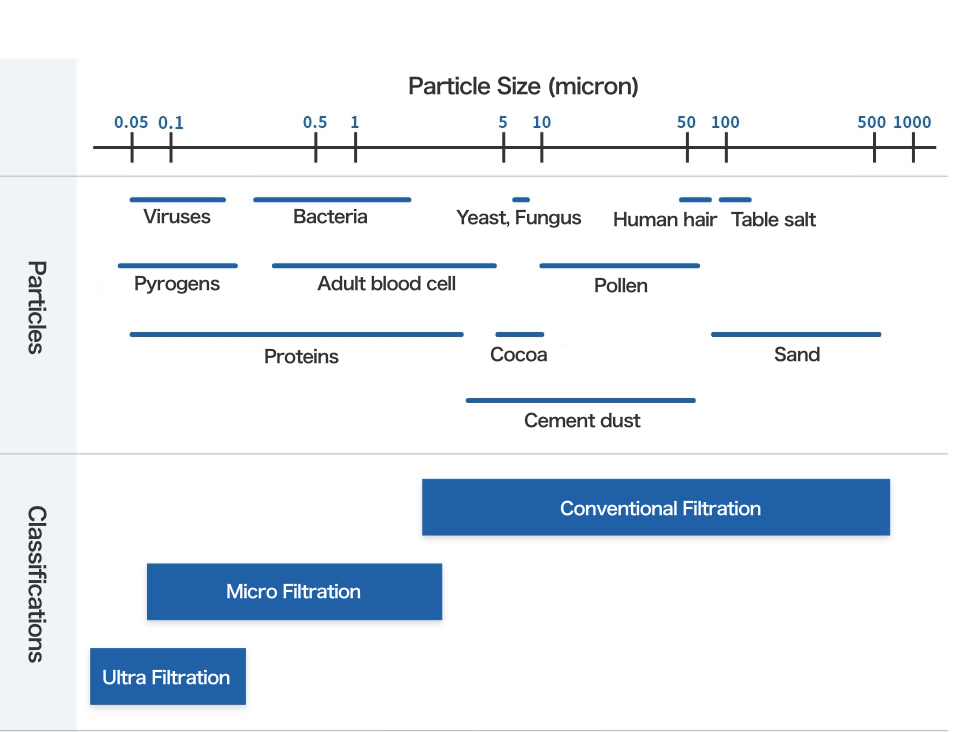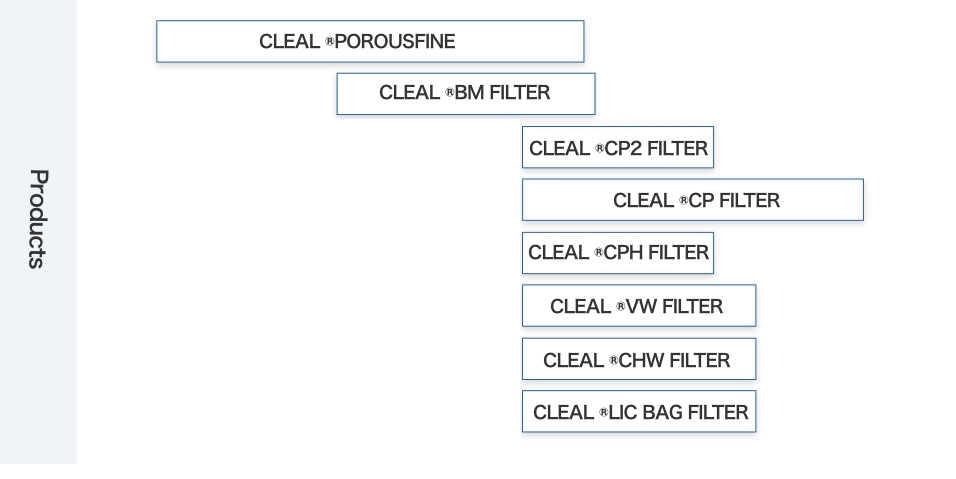*Source: Published by the Association of Liquid Filtration and Purification Industry (LFPI)
「ユーザーのためのフィルターガイドブック ―糸巻き・不織布等編―」
1.What is filtration?
In general, the operation of separating particulate matters of specific particle size or larger or all of them in a fluid with various filter media is referred to as filtration. In addition, a filter medium or a device containing filter medium is referred to as a filter.
Filtration is an essential operation that greatly affects the quality and value of products. There are two main purposes and reasons for using filter.
1-1.Improvement in product value
→ Improvement in appearance, product performance, safety, and stability
<Concrete examples>
- Coating materials: Removal of foreign matters at the time of coating fluid production or coating
- Soft drinks: Removal of particles generated from activated carbon used for removing chlorine
1-2.Improvement in production and treatment efficiency through filtration
→ Improvement in product yield, safety of facilities, reuse and recycling of resources, and waste fluid and exhaust treatment
<Concrete examples>
- Cleaning of electronic components: Recycling of cleaning fluids such as water stored in a cleaning tank
- Rolling oil: Used for keeping the cleanliness of the circulating fluid in a tank at a certain level
- Boiler condensate: Removal of foreign matters and iron for stable boiler operation
- Waste water treatment: Removal of suspended matters in waste water
2.Types of filters
2-1.Classification by filtration model (mechanism)
(1)Surface filtration: A type that traps particles on the surface of a filter medium
(2)Depth filtration: A type that traps particles inside of a filter medium
(3)Cake filtration: A type that cake (liquid-containing solid) itself deposited on the surface of a filter medium acts as a filter medium
2-2.Classification by trapped particle size
(1)Conventional filtration
The filtration range of particles of several μm to several hundred μm (suitable size for mold, pollen, sand, etc.) is applicable. Cartridge filters of metal mesh, filter cloth, laminated non‐woven fabric, yarn wound, or sintered resin are mainly used.
(2)Microfiltration
The filtration range of fine particles and microorganisms of 0.02 μm to several μm is applicable. Non‐woven fabrics and membranes are used as filter media, and the filter used for this application is referred to as a MF filter.
(3)Ultrafiltration
This level of filtration is between nanofiltration and microfiltration. Usually, the filtration range of solutes with molar weights of several thousand to a few hundred thousand or fine particles of several nm to 0.05 μm is applicable. A membrane is used as a filter medium, and the filter used for this application is referred to as a UF filter.
2-3.Classification by form
The filters used for liquid filtration are roughly divided into two types: non-cartridge type, in which the filter is placed in a tank in the form of materials such as sand and activated carbon, and cartridge type, in which the filter is made of filter media, such as natural fibers, synthetic fibers, membranes, and metals, and their constituent members into disc shape, bag shape or cylindrical shape.
2-4.Classification by separation function
Some filters have improved filtration separation efficiency by using the performance of the filter material surface or have other separation functions as well as filtration function. A well-known example is an activated carbon filter that adsorbs and separates organic substances such as chlorine, pigments and odors in a liquid.
3.Classification by structure of filter
3-1.Depth filter
There are a non‐woven fabric laminated type in which non‐woven fabrics are wound in a roll, a yarn wound type in which threads (yarns) are wound around a plastic or metal core material, and a sintered type in which plastic or metal particles are bonded.
3-2.Pleated filter (membrane filter)
Folded type to increase filtration area of non‐woven fabric, membrane or metallic mesh.
3-3. Bag filter
It is a type in which filter cloths or non‐woven fabrics are processed into a bag shape, and by flowing a fluid from the inside to the outside of the bag, the removed materials in the fluid can be trapped in the bag.
4.Filtration rating
Filter manufacturers and filter types have various levels of particle removal efficiency. The indicated filtration rating is based on the standards and evaluation methods (test conditions) independently established by the manufacturer.
4-1.Nominal filtration rating
Each manufacture uses its own standards. For example, a nominal filtration rating of 1 μm can correspond to 15 μm according to the absolute filtration rating.
4-2.Absolute filtration rating
The indication is based on the evaluation methods of filtration rating independently established by each manufacture. In general, the indication is based on the particle removal efficiency (%) or β value (number of particles above a certain size before filtration/number of particles above a certain size after filtration) in the evaluation of the filter, and the particle removal efficiency relative to the indicated rating (μm) is 99.0% to 99.9% or more.
5.Methods of filtration
There are various filtration methods using filter depending on fluid flow methods, filter installation methods, etc., and in many cases various methods are combined. General methods are given as follows:
5-1.Classification by fluid flow method
(1)Continuous filtration
The basic process, in which a filter is installed in the line, and continuous filtration is performed, with fluid passing through the filter only once.
(2) Circulation filtration
The fluid to be filtered is circulated between a tank or a cleaning tank and the filter. It is used when the cleanliness of fluid in a tank or a cleaning tank is to be kept at a certain level.
5-2.Classification by installation method
(1)One stage filtration
Filtration using only one filter.
(2)Multistage filtration
Filtration in stages. It is used when a fluid to be filtered contains foreign matters of high concentration or of various particle sizes.
6.Selection procedure of filtration facilities
For selecting filtration facilities, a procedure for adopting new facilities and a procedure for changing existing facilities are described below.
6-1.Adopting a new system
- After understanding the properties of fluid and foreign matters to be removed, the required amount of treatment, the filtration rating, etc., provide the information to the filter manufacturer.
- Consider the contents of the filters and housings provided by the filter manufacturer.
- Determine the system to be adopted after conducting filtration tests as necessary.
6-2.Changing existing facilities
- Identify changes and problems such as the properties of fluid and foreign matters in the filtration facilities, the amount of treatment, and the filtration rating and provide the information to the filter manufacturer.
- Consider the contents of the change provided by the filter manufacturer.
- Determine the content of change after conducting filtration tests as necessary.
7.Frequently asked questions
7-1.What is a cartridge filter?
A cartridge filter is a filter usually in a cylindrical shape.
7-2.How do you use a cartridge filter?
Prepare housings and pumps according to the flow rate and install them to use.
7-3.What is an ideal cartridge filter?
Requirements of an ideal cartridge filter would be excellent filtration accuracy, liquid (air) permeability and pressure resistance and also long filtration life.
7-4.What is filtration rating?
It indicates the size of particles that can be removed by passing through a filter and is an important indicator of microfiltration. Our company describes filtration rating as "initial particle removal efficiency."
For the filtration rating of our products, please refer to respective product pages.
7-5.How long can a cartridge filter be used? What gives an indication for filter replacement?
There are differential pressure life and aging deterioration life, and the shorter is the replacement time.
The specific time depends on the conditions of use, so it cannot be said as a rule.
Filter Selection Method

Particle size and filtration

